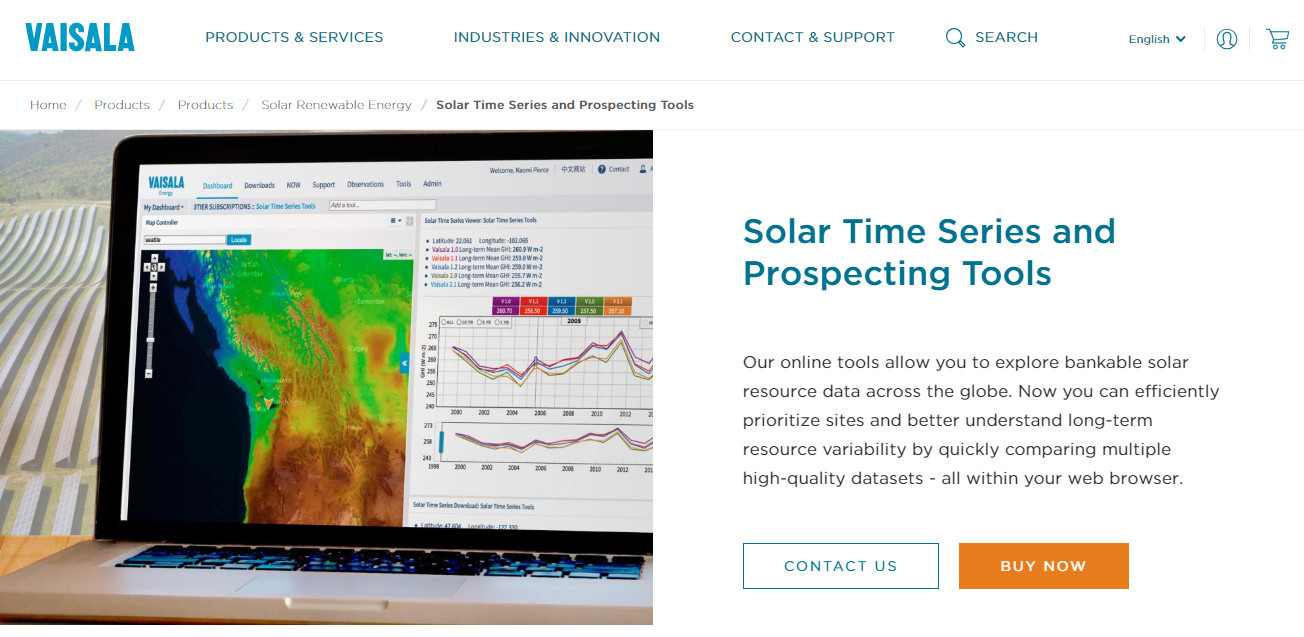Vaisala (3Tier) weather data
Vaisala (previously known as 3Tier) (https://www.vaisala.com/en/products/data-subscriptions-and-reports/data-subscriptions/solar-online-tools) is a US-based company which proposes climate data for the study of Solar Energy systems. Since December 2013, 3Tier is now part of Vaisala. As of Sep. 2018, the 3Tier name is not present on Vaisala website anymore.
The service offers a complete 18-to-20 year satellite derived data files for the whole world, on an hourly base, with a 3 km resolution :
- Global horizontal irradiance (GHI or GlobHor)
- Diffuse horizontal irradiance (DiffHor)
- Direct normal irradiance (DNI or BeamNor) are also available for concentrating systems.
- Ambient temperatures
- Wind velocity
In the 3Tier-Vaisala irradiance dataset, please note that :
- the effect of far shadings from mountains at sunrise and sunset is not included, which means that in mountaneous regions an horizon mask must be applied in the project area of PVsyst.
- the diffuse circumsolar radiation is included :
- in the DHI component (diffuse horizontal), when the DIRINDEX separation model is used, which means in that case that the data is compatible with the use of the Perez-transposition model.
- in the DNI component (difrect normal), when the REST2 clear sky model is used, which means in that case that the data is not compatible with the use of the Perez-transposition model.
The hourly data are available for pay.
Details of the method
(taken from Vaisala 3Tier White paper)
3Tier-Vaisala main source of satellite observations is weather satellites in a geo-stationary orbit. These satellites have the same orbital period as the Earth's rotation and, as a result, their instruments can make multiple observations of the same area with identical viewing geometry each hour. Satellite-based time series of reflected sunlight are used to determine a cloud index time series for every land surface worldwide. A satellite based daily snow cover data set is used to aid in distinguishing snow from clouds. In addition, the global horizontal clear sky radiation (GHC) is modeled based on the surface elevation of each location, the local time, and the measure of turbidity in the atmosphere. 3Tier opted to use a satellite-based, monthly time series of aerosol optical depth and water vapor derived from the Moderate Resolution Imaging Spectroradiometer (MODIS). This data set was combined with another turbidity data set that includes both surface and satellite observations to provide a turbidity measure that spans the period of our satellite data set and is complete for all land surfaces. The cloud index n and the clear sky irradiance GHC are then combined to model the global horizontal irradiance GHI. This component of the process is calibrated for each satellite based on a set of high-quality surface observations.
GHI estimates are then combined with other inputs to evaluate the other irradiance components DNI and DIF. 3Tier-Vaisala may use the Perez-Ineichen DIRINDEX model to do the separation, or directly derive GHI and DNI from the REST2 clear sky model and satellite images.
